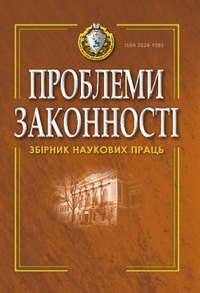Doctrine of methods of interpretation of legal norms formed in the case law of the Court of Justice
DOI:
https://doi.org/10.21564/2414-990X.154.238535Keywords:
methods of interpretation, EU Court, theological method of interpretation, norm of EU law, subject of interpretationAbstract
The doctrinal approaches to the definition of methods and principles of interpretation of legal norms applied by the Court of Justice of the EU are analyzed. The traditional and special methods of interpretation inherent in integration justice are singled out. The dynamics of changes in the approaches to the interpretation of legal norms in the decisions of the Court of Justice of the EU after the signing of the Lisbon Treaty is described. Scientific approaches to defining the concept of interpretation of legal norms contained in domestic sources are analyzed. Foreign sources on the methods of interpretation of the law by the Court of Justice of the EU have been studied. The article analyzes several European publications written at different times before the signing of the Lisbon Treaty and established, which primarily draws attention to authors who have subjected the theological method of interpretation, and very few sources that influence the justification of methods or principles of their application by the Court. It can be concluded that the tendency of European scholars to emphasize the importance of the theological method of interpretation was related to their views on the constitutional nature of the Treaties and legal considerations about the need to adopt the EU Constitution. Such conclusions correlate with the limited jurisdiction of the Court of Justice, as before the signing of the Lisbon Treaty not all provisions of secondary legislation were interpretable (in particular, visas, asylum, immigration and other policies related to the movement of persons). on the constitutionality of the Treaties, although their form and content have become even more similar to constitutional acts, without losing a clear functional statement of provisions. Since then, the case law of the Court of Justice has been characterized by a variety of methods of interpretation, and European doctrine by publications that have re-substantiated the system of methods and paid more attention to their detailed analysis, making each of these methods autonomous and collectively interchangeable.
References
Lemak, V.V., Bandyda, A.Yu. (2019). Tlumachennia prava: problemy vyznachennia poniattia, skladu, praktychnoi potreby. Publichne pravo, 4, 133–143 [in Ukrainian].
Zvonska L.L., Korolova N.V., Lazer-Pankiv, O.V. et al. (2017). Hermenevtyka. Entsyklopedychnyi slovnyk klasychnykh mov. Kyiv: VPTs “Kyivskyi universytet” [in Ukrainian].
Kvit, S.M. (2003). Osnovy hermenevtyky. Kyiv: Vyd. dim “KM Akademiia” [in Ukrainian].
Berniukov, A.M. (2008). Yurydychna hermenevtyka yak metodolohiia zdiisnennia pravosuddia (filosofsko-teoretychnyi analiz). Extended abstract of candidate’s thesis. Lviv [in Ukrainian].
Tsvik, M.V., Petryshyn, O.V., Avramenko, L.V. et al. (2009). Zahalna teoriia derzhavy i prava. M. V. Tsvik, O. V. Petryshyn (Eds.). Kharkiv: Pravo [in Ukrainian].
Rabinovych, P.M. (2021). Osnovy teorii ta filosofii prava. Lviv: Vydavnytstvo LOBF “Medytsyna i pravo” [in Ukrainian].
Koziubra, M.I. (Ed.). (2015). Zahalna teoriia prava. Kyiv: Vaite [in Ukrainian].
Zaichuk, O.V., Onishchenko, N.M. (Eds.). (2006). Teoriia derzhavy i prava. Akademichnyi kurs. Kyiv: Yurinkom Inter [in Ukrainian].
Lecourt, R. (1976). Le rôle de la Cour de Justice dans le développement des Communautès. European Yearbook, vol. 24, 19.
Rishennia Federalnoho Konstytutsiinoho Sudu Nimechchyny vid 5 travnia 2020 r. 2 BvR 859/15. URL: http://www.bverfg.de/e/rs20200505_2bvr085915en.html.
Rishennia Konstytutsiinoho Trybunalu Respubliky Polshcha vid 14 lypnia 2021 r. P. 7/20. URL: https://trybunal.gov.pl/postepowanie-i-orzeczenia/wyroki/art/11589-obowiazek-panstwa-czlonkowskiego-ue-polegajacy-na-wykonywaniu-srodkow-tymczasowych-odnoszacych-sie-do-ksztaltu-ustroju-i-funkcjonowania-konstytucyjnych-organow-wladzy-sadowniczej-tego-panstwa.
Case C-569/08: Internetportal und Marketing GmbH v Richard Schlicht, С-569/08, EU:C:2010:311.
Lenarts, K. Interpretation and the Court of Justice: A Basis for Comparative Reflection. URL: https://core.ac.uk/download/pdf/216908204.pdf.
Schermers, H., Waelbroeck, D. Judicial protection in the European Union. URL: https://books.google.kg/books?id=tZOwH8MvZbAC&printsec=frontcover&hl=ru#v=onepage&q&f=false.
Nial Fennelly. (1996). Legal interpretation at the European Court of justice. Fordham International Law Journal, vol. 20, issue 3, 656–679.
Lenarts, K. Interpretation and the Court of Justice: A Basis for Comparative Reflection. URL: https://core.ac.uk/download/pdf/216908204.pdf.
Lenaerts, K., Gutierrez-Fons, J.A. (2020). Les méthodes d’interprétation de la Cour de justice de l’Union européenne. Larcier.
Syrpis, P.A.J. (2015). The relationship between primary and secondary law in the EU. Common Market Law Review, vol. 52, issue 2, 461–487.
Case T‑61/13: Research and Production Company “Melt Water” UAB contre Office de l'harmonisation dans le marché intérieur (marques, dessins et modèles) (OHMI), Т 61/13, ECLI:EU:T:2014:265 (p. 28).
Case F-29/05: Jean-François Vivier v European Commission, F-29/05, ECLI:EU:F:2010:114 (p. 67–70).
Case C-394/12: Shamso Abdullahi v Bundesasylamt, C-394/12, ECLI:EU: C:2013:813 (p. 51, 62).
Case F‑81/09: Luigi Marcuccio v European Commission, F-81/09, ECLI:EU:F:2011:13 (p. 55).
Case T-124/14: Republic of Finland v European Commission, T-124/14, ECLI:EU:T:2015:955 (p. 24).
Case T-62/10 P: Brigitte Zangerl-Posselt v European Commission, T-62/10 P, ECLI:EU:T:2011:463 (p. 41, 43).
Downloads
Published
How to Cite
Issue
Section
License
Copyright (c) 2021 Ilona Kaminska

This work is licensed under a Creative Commons Attribution 4.0 International License.










